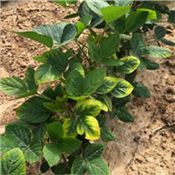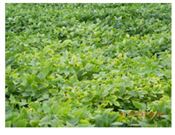How To Diagnose In-Season Potassium Deficiency In Soybean?
DR. RASEL PARVEJ, DR. DAVID MOSELEY,
DR. BRENDA TUBANA AND DR. SAM DODIA
WINNSBORO, LA.
Potassium (K) deficiency can decrease more than 50 percent soybean yield across soil types that range from sandy loam to clay loam.
Potassium deficiency symptoms in soybean first appear as irregular yellowing on the edges of K deficient leaves and can occur as early as at the V3 vegetative stage (three trifoliolate leaves) mainly on the lower older leaves (Figure 1). But symptoms often occur on the upper younger leaves during the reproductive stages especially in severe K deficient soils (Figure 2). Soybean fields with K deficiency symptoms early in the growing season are very easy to diagnose and manage.
However, most of the soybean fields often suffer from K deficiency and exhibit yield losses without showing any visible deficiency symptoms at all or at least until the later reproductive growth stages (beginning seed, R5 to full-seed, R6). This type of phenomenon is called hidden hunger and its most common in soybean fields that are low to medium in soil-test K level, have not received K fertilization, have coarse-textured soils with high leaching potentials due to low cation exchange capacity (CEC) and excessive rainfall, or undergo severe drought conditions. Coarse-textured soils are highly prone to K leaching below the root zone. Sometimes, fall application of K fertilizer in coarse-textured soils results in late-season K deficiency due to K leaching from excessive rainfall during winter and/ or spring. Coarse-textured soils are also poor in water holding capacity and drought in these soils often causes K deficiency by decreasing K uptake by plant roots. In addition, soybean grown in low pH (<6.0) soils often suffer from hidden K hunger effects because low pH decreases soil K availability even after fertilization.
Diagnosing hidden K deficiency early in the soybean growing season is very difficult and requires thorough scouting along with additional information such as fertilization history, soil texture, soil pH, soil- test K level, crop rotation, rainfall amount and distribution after fertilization and during the growing season, drought period, etc.
Tissue sampling during the growing season is the best and perhaps the only tool to diagnose hidden K deficiency in soybean. Tissue sampling is predominantly conducted at the full-bloom (R2) stage; but can be done at the later reproductive (early pod, R3 to beginning seed, R5) stages. However, diagnosis at the early growth stages would be more effective and economical in correcting K deficiency and rescuing yield losses than diagnosis at the later growth stages.
For proper tissue sampling, 15 to 20 recently mature trifoliolate leaves including petioles from the 3rd node from the top of the soybean plant should be collected and the date and soybean growth stage should be recorded (Figure 3). Then the leaflet of each trifoliolate leaf should be separated from the petiole and both the leaflet and the petiole or the leaflet only should be sent immediately to the plant diagnostic lab for K concentration. After receiving the results, tissue K concentrations for both the leaflet and the petiole at the specific growth stage can be interpreted using Figure 4. For example, the critical K concentration at the R2 stage ranges from 1.46 to 1.90 percent for leaflet and 3.01 to 3.83 percent for petiole and any K concentration below the critical level would be deficient and above the critical level would be sufficient. From the R2 stage, critical tissue K concentration declines linearly with the advancement of growth stage due to K translocation from vegetative to reproductive plant parts (pods and eventually seeds). Therefore, the growth stage at the time of tissue sampling should be recorded to properly interpret the tissue K concentration.
Soybean K deficiency can easily be corrected by applying K fertilizer during the growing season. However, the effectiveness and economics of applying K fertilizer to rescue yield loss depends on soybean growth stage and the severity of K deficiency. The earlier the growth stage for K application the more effective and economic it would be in recovering yield loss. Recently, research conducted at the University of Arkansas suggests that soybean K deficiency can be effectively and economically corrected by top-dressing or flying 60 pounds K2O per acre (100 lb Muriate of Potash per acre; 0-0-60) until the R5 stage or about 5-weeks past the R2 stage. Foliar application of liquid K would not be effective and economic to correct severe K deficiency since foliar product contains very small amount of K. Also, foliar product requires several applications since K has a high salt index that can burn soybean foliage if applied in high concentrations. ∆
DR. RASEL PARVEJ, DR. DAVID MOSELEY, DR. BRENDA TUBANA AND DR. SYAM DOODLA: LSU AgCenter Scientists

Figure 1. Potassium deficiency symptoms during the early vegetative growth stages of soybean.

Figure 3. Steps of soybean tissue sampling during the R2 reproductive stage. Pencil in the picture indicates
3rd node from the top of the plant.

Figure 2. Potassium deficiency symptoms during the reproductive growth stages of soybean.

Figure 4. Critical soybean leaflet and petiole K concentration from the R2 to R6 stages.
(Source: Parvej, M.R., N.A. Slaton, L.C. Purcell, and T.L. Roberts. 2016. Critical trifoliolate leaf and petiole potassium concentrations during the reproductive stages of soybean. Agronomy Journal 108:2502-2518. doi:10.2134/ agronj2016.04.0234; Y-axis is changed to English unit)